The Battle for Reconaissance
THE NEED FOR MOBILE LONG RANGE SURVEILLANCE (LRS) TEAM CAPABILITIES

Iraq 1991.. .
The Desert Storm air campaign has been underway for days.. the Iraqi Air Defense System's command, control and radars have been destroyed or suppressed. A coordinated air defense mixing fighter aircraft, guns (AAA) and missiles (SAMs) isn't possible. A low-level strike of A-6E Intruders from the bloated aircraft carrier USS Saratoga hits targets in Iraq under 1,000 feet at 600+ miles per hour. They encounter thick AAA ranging from small arms to 57mm rapid-firing cannon and hand-held SA-16 SAMs. Every Intruder is shot down except the flight leader who limps back severly damaged. These losses cause U.S. Central Command to direct that all U.S. aircraft fly attack missions from at least medium altitude (above 10,000 feet) to avoid enemy air defense weapons. The Royal Air Forces' Tornado aircraft continue low-level strikes at supersonic speeds but heavy losses force them to medium altitude attack profiles when their laser targeting pods become available.
In Iraq, there is few areas of broken terrain to fly low-level terrain masking flight profiles; and presently we have no way of suppressing all small arms, AAA and hand-held SAMs that an enemy infantry force could have; though an Airborne smokescreen capability would be a start for parachute insertions. Thus the tactic of vertical stand-off was employed to offset our lack of low-level air supremacy-superiority yes, complete control, no.
Getting LRS teams into named areas of interest
If small, fast moving (600 MPH +) jets found it impossible to survive at low-altitude in an Iraq-type environment, how will the C-130 at half the speed (300 MPH) and twice the size be able to survive to fly to drop zones within a day's march distance of enemy-held NAIs for the air delivery of LRS teams? When AC-130 gunships rescued marines trapped by the Iraqi attack on Khafji, one was shot down by a SA-16 SAM, when it stayed on station into daylight hours.
In Bosnia, C-130s were successful airdropping food at night at 10,000 feet using free-drop and delayed opening parachutes. If LRS teams are military free-fall qualified or we finally adopt drogue-chute activated parachutes, they could use vertical stand-off and enter the NAI without endangering the C-130 but the enemy will have "painted" the aircraft with radar and been alerted to the general insertion area when the plane slows down to drop speed.
As time goes on, the use of vertical stand-off will decrease in effectiveness as enemy weapons/sensor ranges increase. What is needed is a way to regain clandestine LRS team entry where no radar, visual or infared detection is possible-a tactic of horizontal stand-off, where LRS teams airdrop away from enemy air defenses. The low foot mobility (less than 3 MPH) of rucksack-laden LRS teams causes planners to drop them close to or on top of the objective within about 25 miles or a day's marching distance. 25 miles away from a NAI surrounded by long-range and mobile Air Defense Artillery is not enough to insure aircraft survival and mission accomplishment. LRS teams do not have the entire night available for an approach march-they must dig, construct and camouflage a hide site invisible to the naked eye before dawn.
If helicopters are available, they could fly the LRS team from very-low altitudes (5 -10 feet) by avoiding enemy forces horizontally using a carefully planned route. As the world urbanizes, ultra-low-level flight which was used to get Special Forces recon teams into Iraq will not be possible. Even with closed terrain, helicopters make noise that easily alerts the enemy that we have Soldiers on foot nearby. Helicopters will not always be available-especially during the initial days of an Airborne assault. We need another stand-off platform that is stealthy.
Keeping LRS teams in named areas of interest
D-minus one; Operation Desert Storm...A 160th Special Operations Aviation Regiment (160th SOAR) Blackhawk helicopter flying under 10 feet above ground level flies in a recon team from the 5th Special Forces Group (Airborne). WO Randy "Bulldog" Ballwanz's Special Reconaissance (SR) team moves a short distance on foot to their hide site observing an Iraqi highway and begin digging furiously-they must be done by sunrise. After dawn, an elderly man and his daughter spot their hide site and walk towards it despite their camouflage. The SF Team leader chooses not to kill the Iraqi villagers, who promise not to tell others in their community of the Americans being nearby. Compromised, the team moves on foot to a new location 500 meters away. Within minutes Iraqi military trucks full of armed Soldiers converge on the team's old and new positions. The SF team leader snipes and kills the Iraqi commander and a fierce firefight begins. The SF SR team uses a signal mirror to identify their position so a USAF F-16C Fighting Falcon can drop ordnance on the Iraqis, preventing them from being over-run or having to split up to escape and evade (E & E). The SF team is rescued in the nick of time by a Blackhawk helicopter, which is damaged by gunfire.
The Jungle; Vietnam... marine recon teams are continually ambushed after inserting into large open landing zones (LZs) from noisy helicopters. The Viet Cong/North Vietnamese Army units maintain physical control of the battlefield by mining/booby-trapping likely LZs and having scouts to warn of incoming helicopters. Unable to do anything about helicopter noise, Recon teams accept "compromise" as a way of life and take steps to evade the enemy via dummy insertions and to move on despite enemy detection.
The tropics...
An opponent to the newly elected president, masses a mechanized force to assault the capital for a coup. He keeps his force moving in their "technicals" (civilian trucks with machine guns, recoilless rifles mounted) to prevent targeting by U.S. survillance assets from the air/space. The 82nd Airborne is sent in to secure the capital and airport. Their secondary mission is to find, fix and destroy the rebel forces but the Division's LRS teams are only configured to recon from static-hide sites.
The Mountains; prelude to the Second Korean War...
Saboteurs infiltrating by radar-invisible AN-2 "Colt" aircraft parachute into key ports/ airfields denying their use to U.S. reinforcements. A massive artillery barrage blows holes in the South's defensive lines, where thousands of light infantry swarm through intent on over-running the South and uniting it by force in under 7 days. Knowing that U.S. air power will try to stop their advance, the North Koreas stay dispersed and moving. Ahead, their scouts scour the countryside looking for dug-in LRS teams. Their mobile air defense artillery scans the skies looking for U.S. Paratroopers. They know that U.S. precision guided munitions (PGMs) will need accurate ground reconnaissance to pinpoint targets to be fully effective.
Even if LRS teams can get by the North Korean's counter-reconaissance efforts, if they stay in static positions, they will be soon over-run and isolated. Low on food, it will be difficult if not impossible to extract them in the middle of the enemy's attack echelons. Even if helicopters were available for duties other than transporting infantry to the front.
Where is the enemy's focus of main effort? The 82nd Airborne Division flying to drop zones to establish blocking positions needs to know. To know they need "eyes on the ground" which means LRS teams. Without ground mobility, the only LRS teams able to be emplaced are soon over-run by the rapid North Korean advance; these teams operating as part of the 2nd Infantry Division are only expected to be combat effective for a matter of hours before their batteries run low.
We must fight for reconaissance
Future adversaries have studied the Gulf War and realize that U.S. firepower is dependant upon accurate reconaissance. To think that remote sensors and unmanned aerial vehicles with "soda straw" vision are going to be able to see the enemy without him being alerted (re IDF naval commando raid in 1997 that was compromised by UAVs) is dangerous.To think that a competent enemy is going to allow us to insert/extract LRS teams without a fight is naive. We must "fight" for our reconaissance by being more flexible, mobile and unpredictable.
1. To gain reconaissance, we need MOBILE LRS teams who do not depend on noisy motor vehicles (helicopters, trucks, airplanes) to deliver them close to or on top of NAIs. It is noisy, often wheeled motor vehicle insertion into predictable locations that compromises LRS teams in the first place; LZs, road junctions etc. Motor vehicles are noisy, give off heat/dust signatures visible to the naked ears/eyes for miles away and even more apparent to an enemy equipped with thermals/night vision devices. The growing Air Defense threat makes close delivery by non-stealthy motor vehicle untenable on the non-linear battlefield (NLB) where foes and unfriendly civilians are all around.
2. To maintain reconaissance, we need MOBILE LRS teams that can move to alternate hide sites if compromised-to withdraw a team just because it has been spotted is the same as surrendering the battlefield to the enemy and a sign of tactical inflexibility. Plans do not survive the realities of war. Move on and improvise. To stay in the immediate area after being detected awaiting a helicopter extraction under fire is dangerous. Even the ballistic-protective Blackhawk helicopter isn't bullet-proof; this was sadly learned from the recent combat in Somalia. Helicopter emergency extractions often result in more dead and wounded men trapped behind enemy lines, in some ways making matters worse.
Mini-Gavin Light Tracked Tanks: "Mother" Stealthy, Armored Cross-country Mobile Platforms for Non-Linear Battlefields
 www.youtube.com/watch?v=ddnntGA8vEs
www.youtube.com/watch?v=ddnntGA8vEs
 U.S. Army Experimental Combat Unit Commander and Center for Lessons Learned Call for the Mini-Gavin Reconnaissance Vehicle
U.S. Army Experimental Combat Unit Commander and Center for Lessons Learned Call for the Mini-Gavin Reconnaissance Vehicle
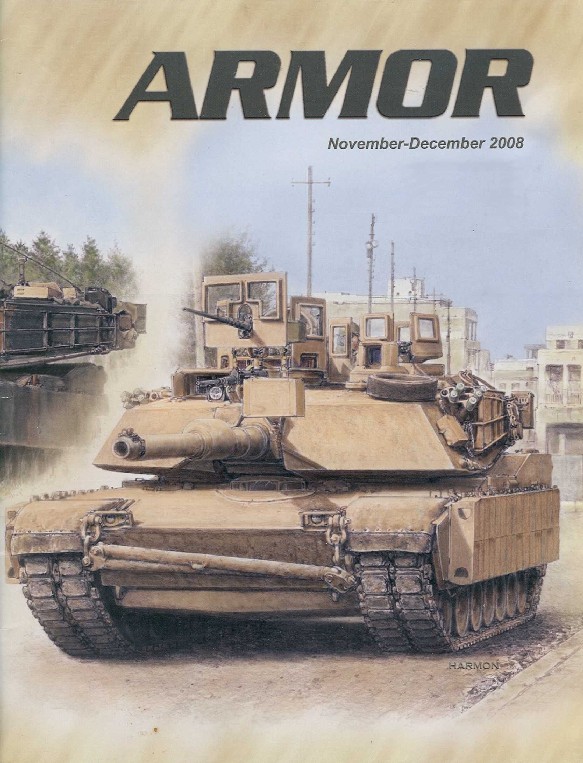
U.S. Army ARMOR magazine, November-December 2008 pages 38-39, Major Jaren K. Price writes in "The Battlefield Surveillance Brigade: the Future of Division-Level Intelligence, Surveillance and Reconnaissance":
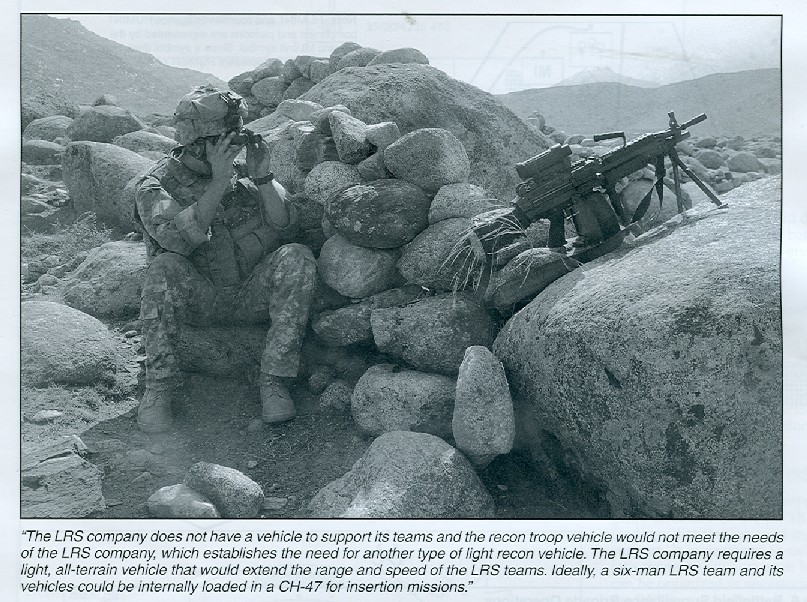
Recommendations for ConsiderationAs with any new organization, many strengths and weaknesses are not evident until the unit is deployed to perform its actual mission. The 525th BFSB, in conjunction with the U.S. Army Center for Army Lessons Learned [CALL], has begun to identify some of these shortfalls. However, if a unit is not resourced or employed as it was designed, the unit and concept cannot clearly be evaluated. Currently, the 525th BFSB is neither resourced nor being deployed as designed. However, based on lessons learned from the deployment of various BCTs, the deployment of the 525th BFSB, and simulations and exercises involving the BFSB, I recommend several items for immediate consideration.
Develop Light Reconnaissance Vehicles
A fourth recommendation is for the Armor Center to reevaluate the needs of the Army for light reconnaissance vehicles and design and procure new vehicles. One critique that has resurfaced repeatedly in the BFSB design is using the HMMWV [wheeled truck] as a reconnaissance vehicle in both the recon troops and, LRS companies.
For the recon troops, critics point out that the HMMWV [wheeled truck] lacks the protection, firepower, and the essential suite of cameras, sensors, and lasers required of a reconnaissance vehicle. While the standard [unarmored] 1025/26 HMMWV [wheeled truck] has advantages, such as [limited] off-road mobility and could be sling-loaded by Army helicopters, the needed change to up-armored vehicles negates these advantages. The ideal vehicle for the BFSB and the infantry BCT (IBCT) recon troops would include the following options: be sling-loadable by helicopter (also internally loaded on a CH-47); provide armor protection from small arms, up to 12.7mm [heavy machine guns] and mines/IEDs; have an organic suite of sensors that could be used on the move; have a mast antenna for employment while stationary; be capable of mounting a variety of weapons (M2, Mk19, M240); have high off-road mobility; carry a minimum of six Soldiers (crew of two and four dismounts) and equipment; have a range of 350+ miles; and have the ability to run various electronic equipment from an internal power source.
The LRS company does not have a vehicle to support its teams and the recon troop vehicle would not meet the needs of the LRS company, which establishes the need for another type of light recon vehicle. The LRS company requires a light, all-terrain vehicle that would extend the range and speed of the LRS teams. Ideally, a six-man LRS team and its vehicles could be internally loaded in a CH-47 for insertion missions. At a minimum, it must be lightweight and small, sling-loadable, and able to carry LRS Soldiers and their equipment without resupply for 5 to 7 days. The vehicle must be highly mobile and nearly silent, and would serve primarily as transportation to increase the LRS teams' mobility and not as a fighting or reconnaissance platform. The vehicle would carry between 1 to 3 people; the key is that the entire LRS team and vehicles are CH-47 transportable. They must also be transportable by medium tactical vehicles, either internally or on standard Army trailers.
Notes
1. U.S. Army Combined Arms Center, "Operational and Organizational Concept for the Battlefield Surveillance Brigade," Fort Leavenworth, KS, I May 2007.
2. Headquarters, Department of the Army, U.S. Army Field Manual (FM) 3-0, Operations, U.S. Government Printing Office, Washington, DC, February 2008.
3. "Operational and Organization Concept for the Battlefield Surveillance Brigade," Figures 1 through 6, 1 May 2007.
Major Jaren K. Price is currently the S2, 1st Heavy Brigade Combat Team, 2nd Infantry Division, Korea. He received a B.A. from Webber State University and an MA from American Military University. His military education includes the U.S. Army Command and General Staff College, Military Intelligence Captains Career Course, Scout Platoon Leaders Course, and Armor Officer Basic Course. He has served in various command and staff positions, to include chief, Special Doctrine and Doctrine Author, Combined Arms Doctrine Directorate (CADD), Fort Leavenworth, KS; commander, Headquarters and Headquarters Support Company, 311th Military Intelligence (MI) Battalion, 101st Airborne (ABN) Division (DIV), Fort Campbell, KY; assistant S3, 311th MI Battalion, 101st ABN DIV, Fort Campbell; S2, 2nd Battalion, 327th Infantry, 101st ABN DIV, Fort Campbell, and Kosovo; and tank platoon leader and company XO, 1st Battalion, 77th Armor Battalion, Schweinfurt, Germany, and Bosnia.
Mobile Reconaissance capabilities via folding All-Terrain Bicycles
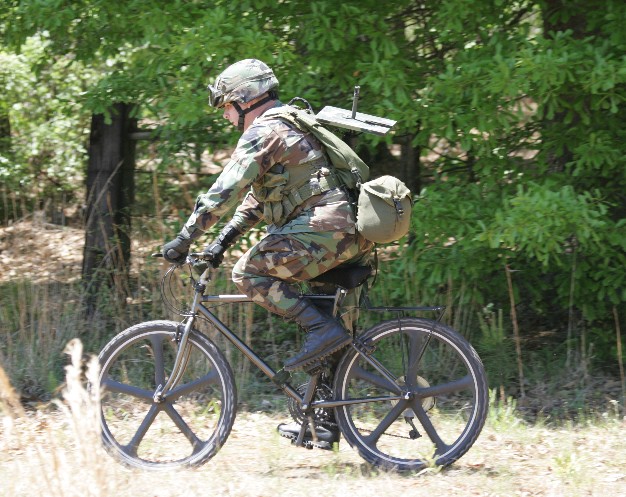
LRS teams operating away from their stealthy, hybrid-electric-drive, Mini-Gavins can become highly mobile (5-20+ MPH) by using folding All-Terrain "Mountain" Bicycles. In the Aug-Sep 1998 issue of U.S. Army Armor magazine, it was reported that bike scouts have been operating non-folding, air-filled tire mountain bikes from 8x8 wheeled Light Armored Vehicles to give motorized forces a "recon" capability before the motor vehicle's signature gives the force's presence away to an alert enemy. Likewise, ATB mobility can be used to air insert outside of earshot of enemy air defense artillery and then move from low-threat areas into high threat areas keeping a healthy horizontal stand-off. Once the stand-off distance is traversed in a few hours, the ATBs are folded, camouflaged and cached in the same manner a SEAL team does to its stealthful mobility platform (rubber boats). The LRS team approach marches the final distance to the hide site in extreme stealth on foot. This will insure the team is not detected in any way during insertion; the delivery aircraft do not have to fly high for vertical stand-off nor fear every weapon from rifles to SANS hitting them from low-level flight-so normal static-line parachuting can be used.
If the team should get compromised, it can return back to its ATBs/Mini-Gavins and use them for high cross-country mobility to move a significant distance between them and their pursuers-they could move to another hide site to complete the mission or to a pick-up zone (PZ) where the extraction helicopter doesn't have to face intense enemy fire. ATBs could even be used to exfiltrate all the way back to friendly lines.
LRS teams have used ATBs in the past in Germany, (Radfahrtruppes) but the concept got a poor reputation when bikes broke down, leaving the team in a bad position. This was because the ATBs were not MILITARIZED to meet military demands. The 1st Tactical Studies Group (Airborne) has put together a rapidly-folding ATB that doesn't have air-filled tires that can go flat. Our non-profit group has used commercially-available, off-the-shelf parts (COTS) like solid foam filled tires to prevent ATB field break-downs. The militarized ATB costs about $360 retail and can be painted with radar-absorbant paint available from the supply system to make it radar resistant.
The important improvement over the ATBs tried in years past is foldability. The ATB by being able to fold in seconds to half-size allows it to be jumped attached to the LRS Paratrooper as a lowering line load, en masse using 2 x A-21 door bundles and/or carried on/off aircraft and ground vehicles. It subliminates itself into other transport vehicles and compacts for clandestine storage in caches. Just like a rubber boat can be deflated to reduce its size. Another improvement is the Extreme Terrain Bike (ETB) with 10 inch wide tires that can traverse soft sand and snow that would force Soldier cyclists on narrow tire ATBs to dismount to push their bikes like a cart. Darby All-Terrain All-purpose Cart/Sleds
Some LRS units are using General William O. Darby All-Terrain, All-Purpose Cart/Sleds (ATACSs) like the UT2000to TOW rather than carry hide site materials and food/water. Using ATACS boosts team ground speed to 4-7 mph and allows greater amounts of supplies to be carried versus manpacking. The UT2000 is also a sled for snow operations and can be used as a Stokes litter/evac cart to MEDEVAC a wounded LRS team member by a hovering helicopter. The ATAC has super-wide tires to traverse most snow and sands.
Thellie Camouflage Suits
The 1st TSG (A) has proven that bikes/carts can be visually camouflaged using ghillie strips during Operation Prove Tactical Mobility at Fort Bragg, NC in 1995. This can be taken a step further by the LRS team members wearing commercially-available "Thellie" camouflage suits that render them invisible to detection by enemy forward looking infared (FLIR) devices.

Teledyne Brown Thellie Home Page
Technological advances have greatly reduced the cost of infrared sensors, resulting in widespread use of very sophisticated surveillance and targeting devices by military forces throughout the world. Teledyne Brown Engineering, long an R&D leader in camouflage for visual and RF suppression, has developed products for countering these infrared devices.
Of particular value is our Thellie Suit, designed to suppress the signature of the human body in the visual through thermal infrared bands. This suit enables the wearer to blend into the background when viewed through the best performing infrared imaging devices.
The alternating pictures show images from visible and infrared sensors of a Soldier in standard field uniform (left) and in the Thellie Suit (right).
Constructed of lightweight fabrics in configurations that allow proper ventilation of body-produced heat, the Thellie Suit enables the wearer to freely and comfortably accomplish mission demands. The suit conforms to normal criteria placed on qualified military equipment. The material can also be in a poncho or blanket configuration.
The name "thellie" is a combination of "thermal" -- denoting the suit's IR suppression capability -- and "ghillie" -- the name for Irish and Scottish gamekeepers who used homemade camouflage suits to stalk game poachers.
This product is available only to authorized customers in U.S. Government agencies.
For additional information, contact:
Jerry C. Edwards
jerry.edwards@tbe.com
(256) 726-1000 ask operator to connect you
Lightweight LRP rations
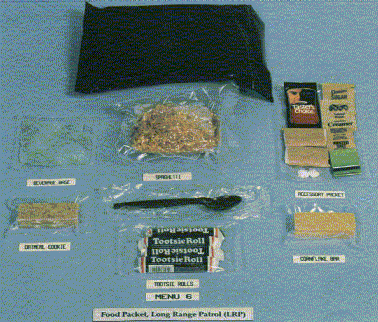
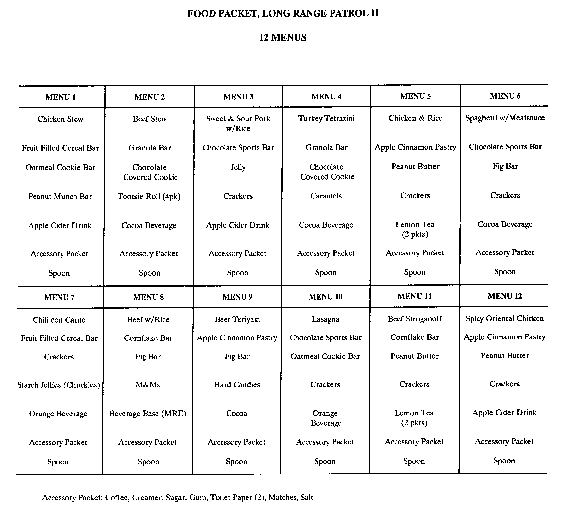
Ironically, the U.S. Army supply system has dehydrated LRP rations that weigh half as much as MREs (20 meals per box instead of just 12) that could be ordered by LRS units to lighten their mission loads as well as increase their surveillance time. But many LRS units are unaware of these items and Soldier on with the messy, heavy MREs. LRP NSN: 8970-00-926-9222. LRPs come 16 per a case compared to just 12 meals per MRE case.
Better water logistics
Water is a major thorn in the side of deep recon units. In the Gulf war, British SAS recon team "Bravo Two Zero" trudged on foot from CH-47 Chinook helicopters into a desert hide site with 50 pound 5 gallon water cans in hand. They were eventually detected and E & Ed with the Iraqi Army in hot pursuit. Had they been equipped with Human Powered Vehicles (ATBs, ATACSs) this may have been avoided entirely. One handicap that can now be corrected is the clumbsy 5 gallon plastic water can which can be replaced with a 5 gallon collapsible water bag. These bags are disposable as well costing only .80 cents each and have been field proven by the U.S. Army's 25th Light Infantry Division ("Tropic Lightnings") in Hawaii. Click on the link supplied to learn the details of how to order these water bags and how they can be used to support LRS team operations.
Another problem area is parachute injuries from landing on hard plastic 1 quart canteens and their general bulk and noisiness. This problem can be solved by using flexible, 1 quart canteens:
New G.I. flexible one-quart canteens
Ordering Information
The Lighthouse Store
P.O. Box 14959 Seattle, WA 98114 - 0959
Voice (206) 322-4200
TTY (206) 324-1388
Fax (206) 329-3397
www.lighthousestore.com
Stock # Description Unit Cost
CN 0040 1-quart canteen, collapsible $7.20
NSN 8465-00-NIB-0041
Canteens come with NBC mask drinking tube interface cap.
Add your state sales tax, and shipping/handling for the box needed to send the number of canteens you ordered.
PROBLEM SOLVED!!!!
In fact, the flexible 1-quart canteen greatly improves the water flow through the drinking tube of your M40 Field Protective Mask because the canteen body can be squeezed. Edgewood Arsenal Tests (Chemical Biological Defense Command) showed 2 times the water flow rate while drinking through the new Joint Services Protective Mask using the flexible 1-quart canteen compared to old, hard-shell plastic canteens.
Waste absorbption products
There are several products available commercially that can absorb body waste material completely to bolster LRS team hide site hygiene/sanitation practices as well as improve their signature reduction to avoid enemy detection. Several of these products are now DOD approved and have National Stock Numbers (NSNs) so unit supply NCOs can order them.
Army Logistician, Jan-Feb 1995 reports:
The Defense Construction Supply Center (DCSC) Columbus, Ohio stocks absorbption products made by American Innotek(c) Inc, 1565 Creek Street Suite 108, San Marcos, Ca 92069 (619) 471-1549 FAX: -2270 Homepage: http://briefrelief.com, Email: roland@briefrelief.com They are:
Disposable Urinal Bag, NSN 4510-01-379-0177 $2.15
Solid Waste System NSN, 4510-01-379-1341 $2.92
Daily Restroom Kit NSN, 4510-01-379-0190 $5.99
Each of these products fit into the BDU pocket. POC is Maxine Copeland, DSN 850-1258 or commercial (610) ???-1258.
The problem with these is a LRS team will need multiple bags to handle multiple waste events. The costs to a unit will rise accordingly. These devices are good for one time use on board an aircraft or on a flightline while rigged for a parachute jump, but not extended field use. American Innotek(c) Inc has a larger "Disposa-John(c)" which is based around a 5 gallon bucket NSN 4510-01-379-1341 for multiple uses by several people over time, say in a LRS team hide site or Armored Fighting Vehicle (AFV). However the bucket does not collapse, though it could be used in conjunction with the modified MRE ration case which does collapse described below.
MRE Porta-Latrine
A inexpensive, simpler and compacting latrine can be created using a MRE case. The MRE case and sleeve flattens until needed, ideal for a LRS team already over-loaded with mission gear. A small box of scoopable cat litter inexpensively obtained from a grocery store, 100 mph tape and a heavy duty trash bag are all that are needed.
The MRE Porta-Latrine is prepared by cutting two holes on one nd of the box's narrow side and where the sleeve will slide over. This is where you will do your "business".
Next, you arrive on the scene and are well underway digging your hide site. Dig a small hole in a corner of the hide site for the team's porta-latrine to sit half-way into the ground. The MRE Porta-Latrine will act as a small seat to sit on while doing your "business". Unflatten the MRE case and tape its flaps into an open position. Place the trash bag into the hole and tape down onto the sides of the entry hole. Slide the sleeve over with its hole aligned with the other hole. Tape sleeve down. Insert entire porta-latrine into its recessed hole position. Pour kitty-litter into the hole to line trash bag for absorbption when used. After each use, pour a little kitty litter into the hole.
The MRE Porta-Latrine will last for at least a week's worth of a LRS team's food/drink generated waste. The MRE Porta-Latrine will work very well within the confines of an AFV, so the vehicle need not have to stop in order for crewmen and/or dismounts to have to relieve themselves--a tactical advantage.
When the LRS team is done, the MRE Porta-Latrine can be left in place with the last kitty litter poured into it to absorb odors, and the hide site filled in if time/mission permits. The AFV crew can bury their MRE Porta-Latrine when the situation permits.
Putting it all together
At the battle of Gettysburg, Buford's cavalry were the first to gain the heights that proved crucial to victory. They were mobile enough to arrive before the enemy's main body and its scouts. The same challenge faces us in Korea, where another mobile light infantry force backed by armored fighting vehicles threatens to swarm and over-run the airfields/ports of the South before U.S. forces can deploy. U.S. Airborne forces will be key to the defense of the South because they can deploy by parachute directly into blocking positions. But these forces constitute the strategic reserve of the U.S. and must be employed carefully; LRS teams must go in first and determine the enemy's main effort and provide targeting information for our air power enemy infantry will not be as easily detected as 50 ton tanks in the open desert. Our LRS teams need to be mobile enough to avoid enemy air defenses and detection. Once on the ground, they need organic mobility to re-position to meet new intelligence demands and to insure mission accomplishment and survival. The stealthful mobility platform for ground movement is the folding all-terrain bicycle just as the rubber boat is to water and the parachute is to the air.
Today's folding ATBs can be combined to other mobility platforms to create unpredictable infiltration/exfiltration routes. The team mobility plan can be modified according to the mission, enemy, terrain etc. ATB/ATACs are low-cost mobility devices that can be easily purchased by individual units using their own funds. A suitable folding ATB and parts is available retail to meet military demands. 1st TSG (A) has developed an airdrop bag for parachute jumping as a lowering line load attached to the Paratrooper. ATBs/ATACs can be dropped as door bundles or as rear ramp CDS bundles. We have already conducted a major Airborne operation DARK CLAW where the folding ATBs wwere airdropped attached to the Paratrooper. Upon landing, the ATB was quickly unfolded and cycled into action. Other ATBs were airdropped as a rear ramp skid bundle to prove that technique. After a simulated hostage rescue, the 1st TSG (A) team exfiltrated 30 miles back to Ft. Bragg to demonstrate the high mobility inherent to ATB equipped teams. ATBs can be used now during daily physical fitness training to build stamina and cycling skills and during field training exercises to perfect movement/cache techniques.
The use of today's multiple-speed, fat tire ATBs by police/military units is growing; the British 16 Air Assault Brigade, Special Air Service, Gurkhas, the Dutch Royal Marine Corps uses a folding ATB for rubber boat raids, the Swiss have 3 elite infantry regiments on bikes. The Thai Air Force Commandos are studying folding ATBs for airfield seizure missions. There is no reason why LRS teams must make the Hobson's choice between noisy motor vehicle transport or slow foot travel; an option with speed/stealth is available that is affordable and possible today: the ATB and the ATAC.
References
Rick Atkinson; Crusade; Houghton-Mifflin, 1993
William Smallwood; Warthog; 1993
usmc Research paper * 92-0002 Armor/Antiarmor Operations in Southwest Asia
Mountain Bike magazine, Sept/Oct 1993; Secret Weapon, page 82
S.W.A.T. magazine, November 1993 page 62
Letter to ITSG from U.K. 5th Airborne Brigade, 1993
ESPN Bicycling program on Swiss Bicycle regiments
DTIC File # AD A211 795 "Human Powered Vehicles in Support of Light Infantry Operations"; Major Stephen Tate U.S. Army
The Discovery Channel American Commandos, 1998, (1-800 765-0066 $19.95)
FEEDBACK!